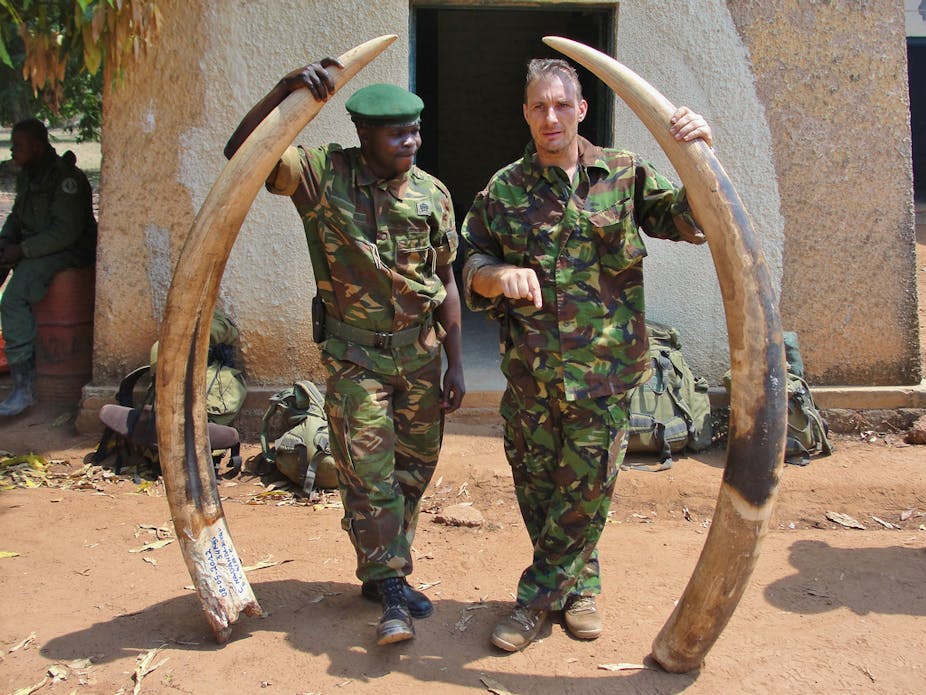Elephant and rhino poaching in Africa have been rising; the Western black rhino has just been declared extinct. Demand in Asia, particularly China, for these animals’ tusks and horns has been identified as the main cause of the rise in poaching. Many organisations are moving towards a militarised anti-poacher approach, but there is scant evidence this approach is working.
The media, guided by certain non-governmental organisations, have reported claims that terrorist groups such as Al-Shabaab and the Janjaweed are funded by elephant poaching.
The shocking Westgate Mall incident in Nairobi in September was perpetrated by Al-Shabaab. One writer ventured that the attack could have been financed with only five elephant tusks.
Increasingly, elephant poaching is being linked to organised crime and terrorism, elevating the issue to one of national security. Protecting national security inevitably leads to calls for “sophisticated counter-guerilla warfare”.
The call for militarised anti-poaching measures
Are we to see the emergence of anti-poaching Blackwaters to take on the criminals that are massacring precious elephants?
Anti-poaching consultant Nir Kalron - who has a military background - says “If ranger units are not sufficient to stop the poaching gangs … military sweeps may be necessary… [A]n aggressive ‘shock’ campaign is in order; to achieve such results, the use of large infantry and Special Forces units is needed.”
He continues, writing that hi-tech surveillance should be used: drones, night-vision goggles, GPS trackers, etc. and that “the creation of focused task forces with ‘carte blanche’ – supported financially and professionally by NGOs and security professionals – will offer a possible recipe for success.”
The highest levels in the US and the UN, supported by conservation and animal welfare NGOs, seem to be buying this message.
For example, the recently launched Clinton Global Initiative has pledged a US$80 million effort to fight the illegal ivory trade, with a further US$70 million to be raised specifically for anti-poaching.
Making wildlife a security issue
In 2012, Hillary Clinton (US Secretary of State at the time) publicly called an unprecedented amount of attention to the illegal wildlife trade. She noted how poachers now have helicopters and automatic weapons, which pose a threat to human life as well as wildlife.
Clinton called the illegal wildlife trade a national security issue. Following this, in late 2012, Kenya’s ambassador to the United States urged Clinton to send US Marines to help counteract the increasingly “vicious boldness of the poaching gangs” that are decimating Kenya’s wildlife.
Realising many African countries would be calling for similar assistance, Garry Reid, US principal deputy assistant secretary of defense for special operations, warned, it is “not as simple as providing a piece of kit and waving goodbye.” The host nation must have the will and training to curtail it, with “a steady presence of Special Operations Forces personnel in remote parts of the world.”
Michael Fay, technical adviser to Gabon’s national parks service, told a US congressional committee that, without the aid of military and intelligence services, African governments would lose control of regions destabilised by poachers.
More recently US President Barack Obama launched a new, US$10 million plan to combat illegal wildlife trade and related organised crime and the International Union for the Conservation of Nature is convening a high-level summit involving Heads of State in December dedicated to stopping elephant poaching. It is not known what measures they will seek to enact, but it is clear momentum is building towards militarisation of anti-poaching efforts.
Will it work?
Militarised moves against poaching can have unintended consequences.
The military approach has not succeeded in Kruger National Park in South Africa, reputed to be one of the best managed in Africa and which has by far the largest rhino population in the world, totalling over 10,000.
Sam Ferreira, a rhino specialist with South African Parks, made a presentation on rhino conservation and poaching at the CITES Conference of the Parties in March. He demonstrated graphically that as ranger manpower (including bringing in the South African army), funding for anti-poaching and arrests all increased, rhino poaching skyrocketed.
What? Read that again. Militarisation failed spectacularly. Ferreira concluded that the potential gains for poachers were simply too high for the increased risks to deter them.

There is an alternative
Everyone seems to agree that the ultimate cause lies with Chinese and other, mostly Asian, consumers buying the ivory and other wildlife products. Why not start there and get them to stop buying illegal products?
The problem is, there are no legal ivory or rhino horn supplies for them to buy because of the Convention on International Trade in Endangered Species (CITES) trade bans. Demand is satisfied through poaching.
Let’s look elsewhere to search for a solution. Anybody ever hear of the vicuña? The wild camel relative lives in South America and vicuña wool is one of the most highly priced animal fibres in the world. It was hunted down to about 6,000 animals in 1974, when it was declared endangered, and trade in its wool was banned by CITES in 1975.
Things did not improve until the Vicuña Convention put a plan in place. Conservation programmes focused on local communities and encouraged them to manage vicuñas for their own benefit through selling the wool from controlled hunting and domestication. There are about 350,000 animals today and the population is growing.
The vicuña case shows that allowing trade can benefit a species. I wonder how many would be left if the trade ban had been kept in place and militarised anti-poaching had taken over?
The vicuña approach should be considered with those who live with elephants in Africa and who buy and work raw ivory in China. But will governments and NGOs prefer killing poachers to dealing with the real cause?

